Strategies for Training and Development in Hospitality Industry Report
VerifiedAdded on 2021/06/15
|14
|3226
|45
Report
AI Summary
This report delves into the significance of training and development within the hospitality industry. It begins by identifying performance gaps and the need for effective training programs, encompassing new recruit training, simulating training, certification training, apprentice training, on-the-job training, language training, administration training, and cross-training. The report emphasizes the importance of needs assessment in determining the appropriate training methods and highlights the benefits of development programs for existing employees, including increased competitiveness and enhanced employee skills. It also explores potential negative outcomes if training is not conducted, such as unhappy employees, low production, unsafe working environments, and ineffective management. The report concludes with recommendations for implementing comprehensive training and development strategies to ensure guest satisfaction and overall success in the hospitality sector. The report is a student submission, published on Desklib, a platform providing AI-based study tools.
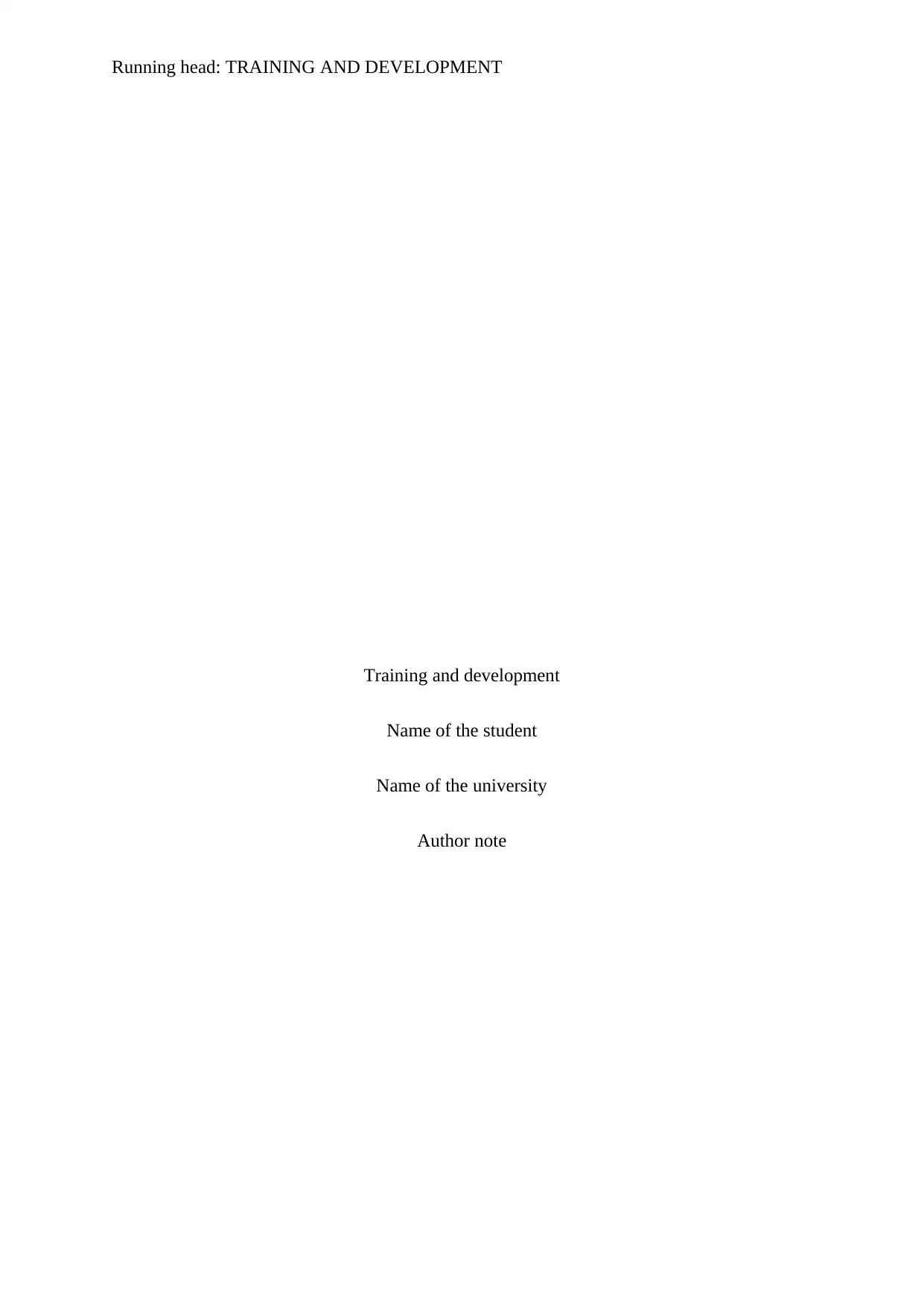
Running head: TRAINING AND DEVELOPMENT
Training and development
Name of the student
Name of the university
Author note
Training and development
Name of the student
Name of the university
Author note
Paraphrase This Document
Need a fresh take? Get an instant paraphrase of this document with our AI Paraphraser
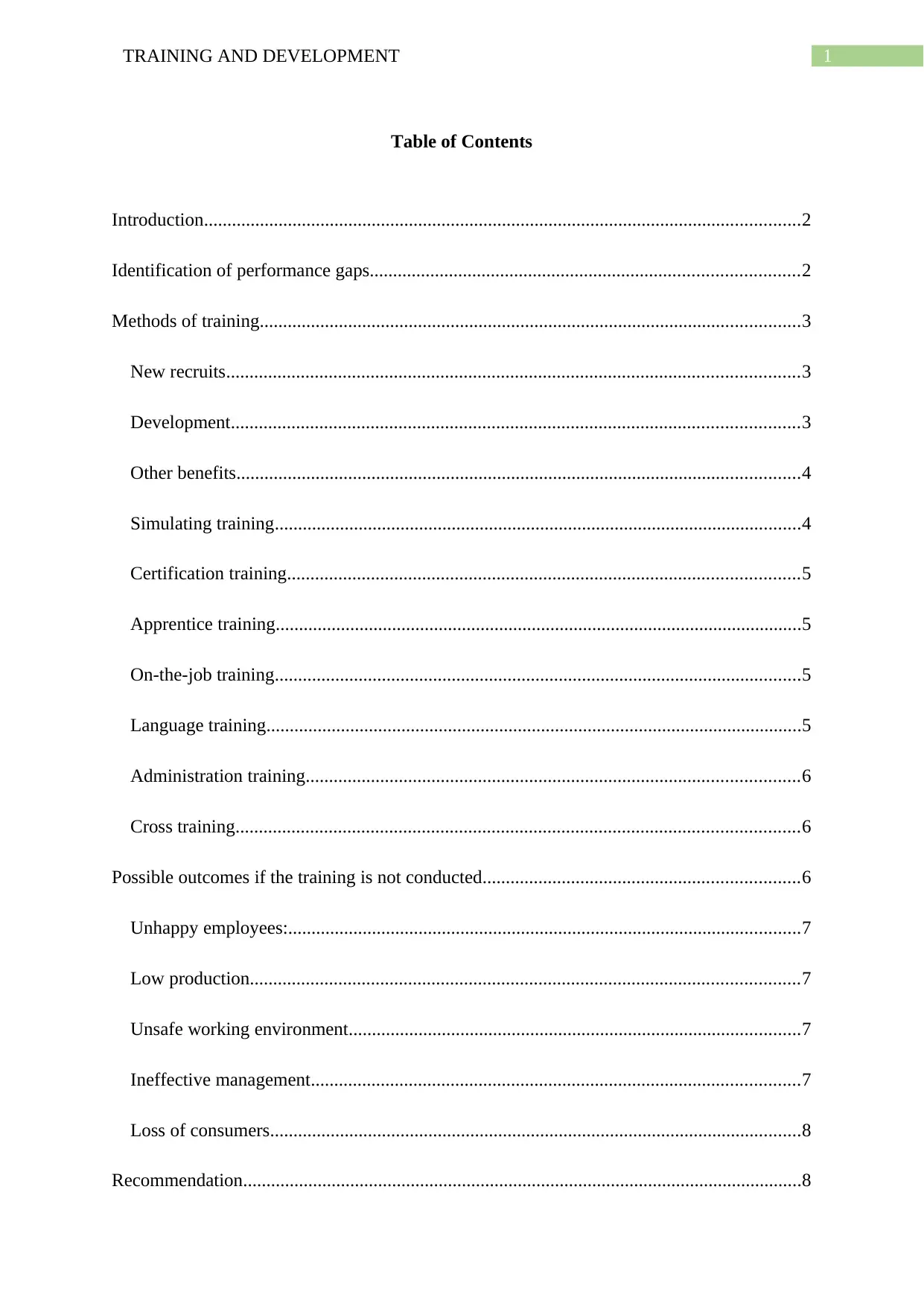
1TRAINING AND DEVELOPMENT
Table of Contents
Introduction................................................................................................................................2
Identification of performance gaps............................................................................................2
Methods of training....................................................................................................................3
New recruits...........................................................................................................................3
Development..........................................................................................................................3
Other benefits.........................................................................................................................4
Simulating training.................................................................................................................4
Certification training..............................................................................................................5
Apprentice training.................................................................................................................5
On-the-job training.................................................................................................................5
Language training...................................................................................................................5
Administration training..........................................................................................................6
Cross training.........................................................................................................................6
Possible outcomes if the training is not conducted....................................................................6
Unhappy employees:..............................................................................................................7
Low production......................................................................................................................7
Unsafe working environment.................................................................................................7
Ineffective management.........................................................................................................7
Loss of consumers..................................................................................................................8
Recommendation........................................................................................................................8
Table of Contents
Introduction................................................................................................................................2
Identification of performance gaps............................................................................................2
Methods of training....................................................................................................................3
New recruits...........................................................................................................................3
Development..........................................................................................................................3
Other benefits.........................................................................................................................4
Simulating training.................................................................................................................4
Certification training..............................................................................................................5
Apprentice training.................................................................................................................5
On-the-job training.................................................................................................................5
Language training...................................................................................................................5
Administration training..........................................................................................................6
Cross training.........................................................................................................................6
Possible outcomes if the training is not conducted....................................................................6
Unhappy employees:..............................................................................................................7
Low production......................................................................................................................7
Unsafe working environment.................................................................................................7
Ineffective management.........................................................................................................7
Loss of consumers..................................................................................................................8
Recommendation........................................................................................................................8
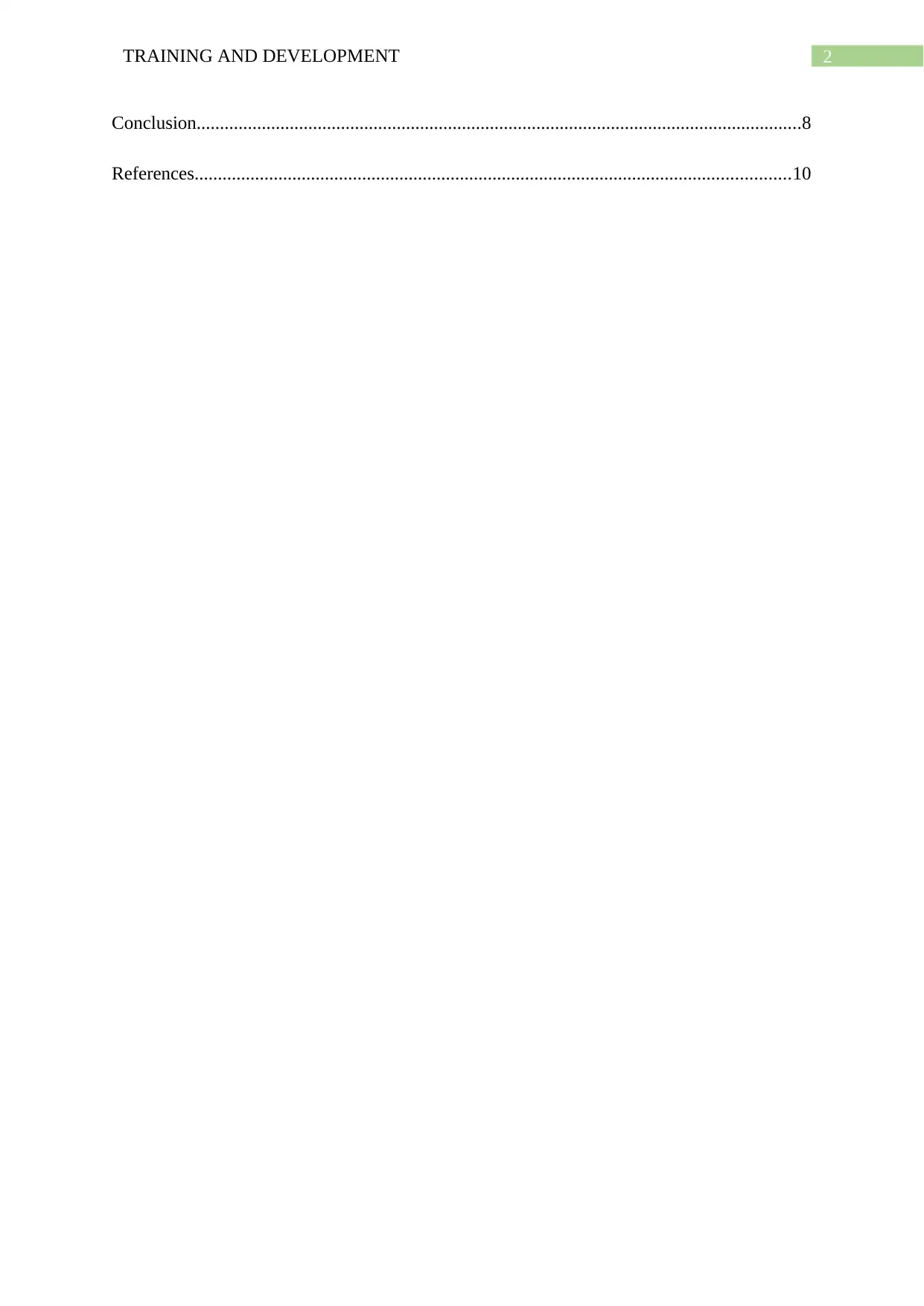
2TRAINING AND DEVELOPMENT
Conclusion..................................................................................................................................8
References................................................................................................................................10
Conclusion..................................................................................................................................8
References................................................................................................................................10
⊘ This is a preview!⊘
Do you want full access?
Subscribe today to unlock all pages.

Trusted by 1+ million students worldwide
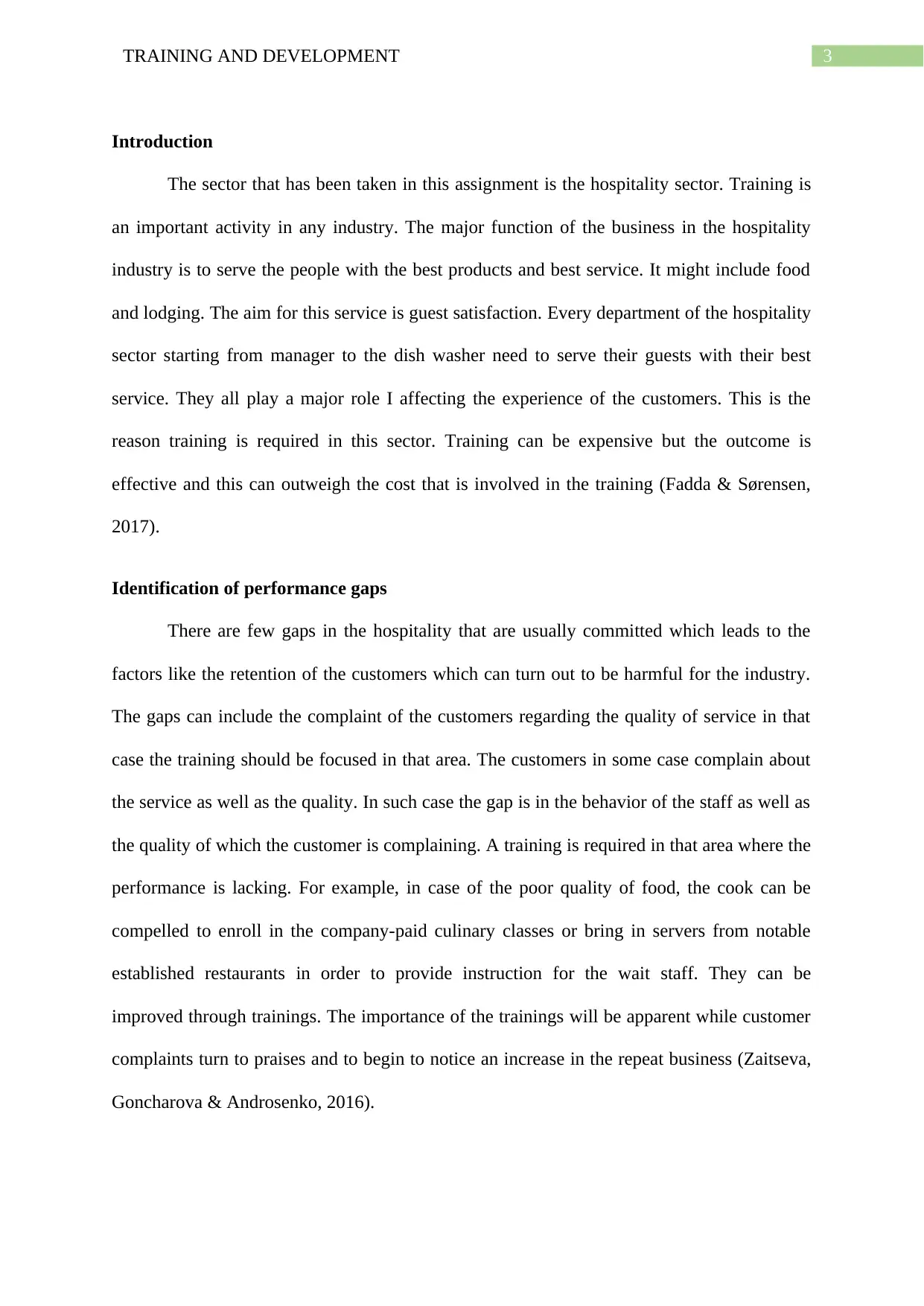
3TRAINING AND DEVELOPMENT
Introduction
The sector that has been taken in this assignment is the hospitality sector. Training is
an important activity in any industry. The major function of the business in the hospitality
industry is to serve the people with the best products and best service. It might include food
and lodging. The aim for this service is guest satisfaction. Every department of the hospitality
sector starting from manager to the dish washer need to serve their guests with their best
service. They all play a major role I affecting the experience of the customers. This is the
reason training is required in this sector. Training can be expensive but the outcome is
effective and this can outweigh the cost that is involved in the training (Fadda & Sørensen,
2017).
Identification of performance gaps
There are few gaps in the hospitality that are usually committed which leads to the
factors like the retention of the customers which can turn out to be harmful for the industry.
The gaps can include the complaint of the customers regarding the quality of service in that
case the training should be focused in that area. The customers in some case complain about
the service as well as the quality. In such case the gap is in the behavior of the staff as well as
the quality of which the customer is complaining. A training is required in that area where the
performance is lacking. For example, in case of the poor quality of food, the cook can be
compelled to enroll in the company-paid culinary classes or bring in servers from notable
established restaurants in order to provide instruction for the wait staff. They can be
improved through trainings. The importance of the trainings will be apparent while customer
complaints turn to praises and to begin to notice an increase in the repeat business (Zaitseva,
Goncharova & Androsenko, 2016).
Introduction
The sector that has been taken in this assignment is the hospitality sector. Training is
an important activity in any industry. The major function of the business in the hospitality
industry is to serve the people with the best products and best service. It might include food
and lodging. The aim for this service is guest satisfaction. Every department of the hospitality
sector starting from manager to the dish washer need to serve their guests with their best
service. They all play a major role I affecting the experience of the customers. This is the
reason training is required in this sector. Training can be expensive but the outcome is
effective and this can outweigh the cost that is involved in the training (Fadda & Sørensen,
2017).
Identification of performance gaps
There are few gaps in the hospitality that are usually committed which leads to the
factors like the retention of the customers which can turn out to be harmful for the industry.
The gaps can include the complaint of the customers regarding the quality of service in that
case the training should be focused in that area. The customers in some case complain about
the service as well as the quality. In such case the gap is in the behavior of the staff as well as
the quality of which the customer is complaining. A training is required in that area where the
performance is lacking. For example, in case of the poor quality of food, the cook can be
compelled to enroll in the company-paid culinary classes or bring in servers from notable
established restaurants in order to provide instruction for the wait staff. They can be
improved through trainings. The importance of the trainings will be apparent while customer
complaints turn to praises and to begin to notice an increase in the repeat business (Zaitseva,
Goncharova & Androsenko, 2016).
Paraphrase This Document
Need a fresh take? Get an instant paraphrase of this document with our AI Paraphraser
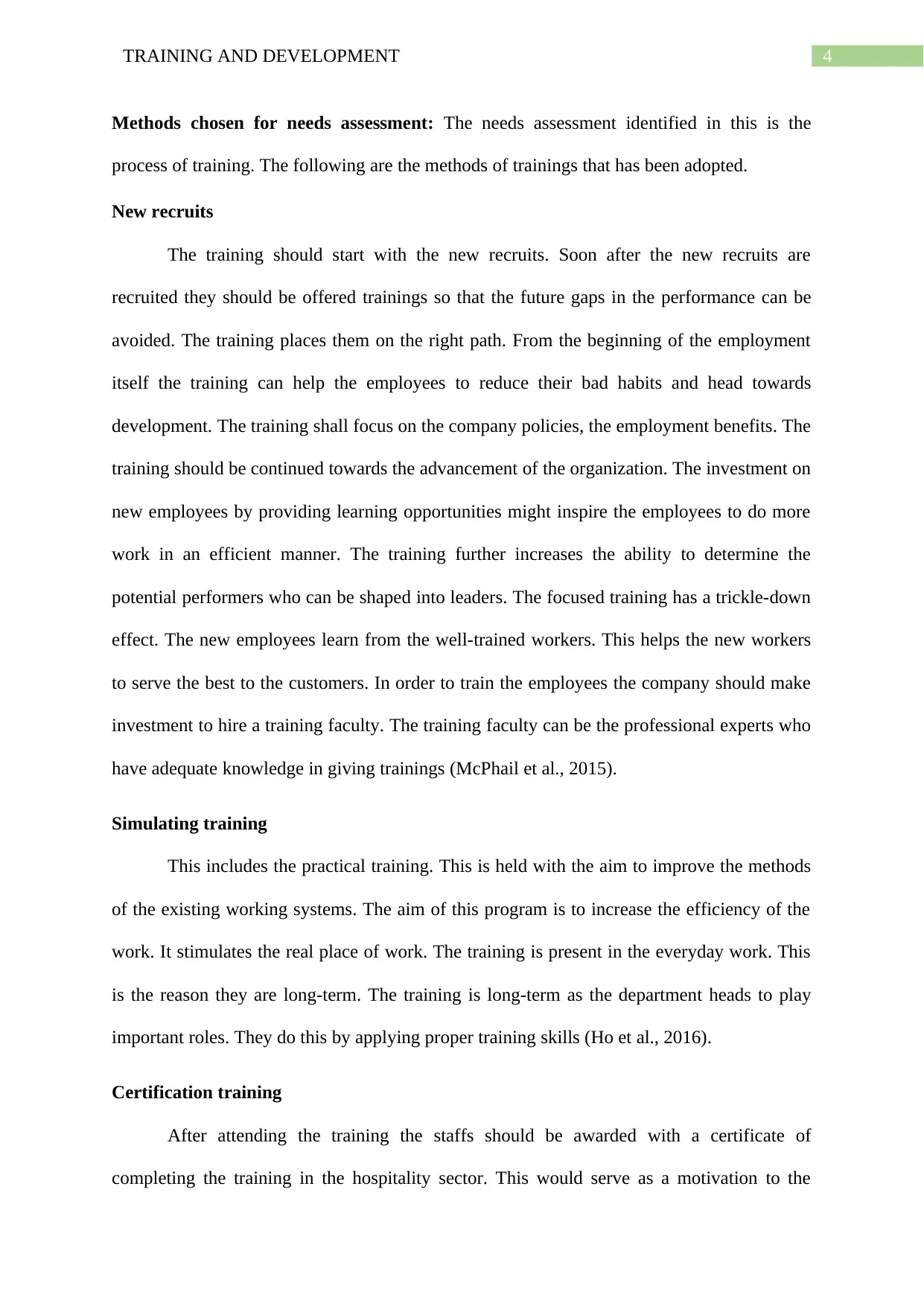
4TRAINING AND DEVELOPMENT
Methods chosen for needs assessment: The needs assessment identified in this is the
process of training. The following are the methods of trainings that has been adopted.
New recruits
The training should start with the new recruits. Soon after the new recruits are
recruited they should be offered trainings so that the future gaps in the performance can be
avoided. The training places them on the right path. From the beginning of the employment
itself the training can help the employees to reduce their bad habits and head towards
development. The training shall focus on the company policies, the employment benefits. The
training should be continued towards the advancement of the organization. The investment on
new employees by providing learning opportunities might inspire the employees to do more
work in an efficient manner. The training further increases the ability to determine the
potential performers who can be shaped into leaders. The focused training has a trickle-down
effect. The new employees learn from the well-trained workers. This helps the new workers
to serve the best to the customers. In order to train the employees the company should make
investment to hire a training faculty. The training faculty can be the professional experts who
have adequate knowledge in giving trainings (McPhail et al., 2015).
Simulating training
This includes the practical training. This is held with the aim to improve the methods
of the existing working systems. The aim of this program is to increase the efficiency of the
work. It stimulates the real place of work. The training is present in the everyday work. This
is the reason they are long-term. The training is long-term as the department heads to play
important roles. They do this by applying proper training skills (Ho et al., 2016).
Certification training
After attending the training the staffs should be awarded with a certificate of
completing the training in the hospitality sector. This would serve as a motivation to the
Methods chosen for needs assessment: The needs assessment identified in this is the
process of training. The following are the methods of trainings that has been adopted.
New recruits
The training should start with the new recruits. Soon after the new recruits are
recruited they should be offered trainings so that the future gaps in the performance can be
avoided. The training places them on the right path. From the beginning of the employment
itself the training can help the employees to reduce their bad habits and head towards
development. The training shall focus on the company policies, the employment benefits. The
training should be continued towards the advancement of the organization. The investment on
new employees by providing learning opportunities might inspire the employees to do more
work in an efficient manner. The training further increases the ability to determine the
potential performers who can be shaped into leaders. The focused training has a trickle-down
effect. The new employees learn from the well-trained workers. This helps the new workers
to serve the best to the customers. In order to train the employees the company should make
investment to hire a training faculty. The training faculty can be the professional experts who
have adequate knowledge in giving trainings (McPhail et al., 2015).
Simulating training
This includes the practical training. This is held with the aim to improve the methods
of the existing working systems. The aim of this program is to increase the efficiency of the
work. It stimulates the real place of work. The training is present in the everyday work. This
is the reason they are long-term. The training is long-term as the department heads to play
important roles. They do this by applying proper training skills (Ho et al., 2016).
Certification training
After attending the training the staffs should be awarded with a certificate of
completing the training in the hospitality sector. This would serve as a motivation to the
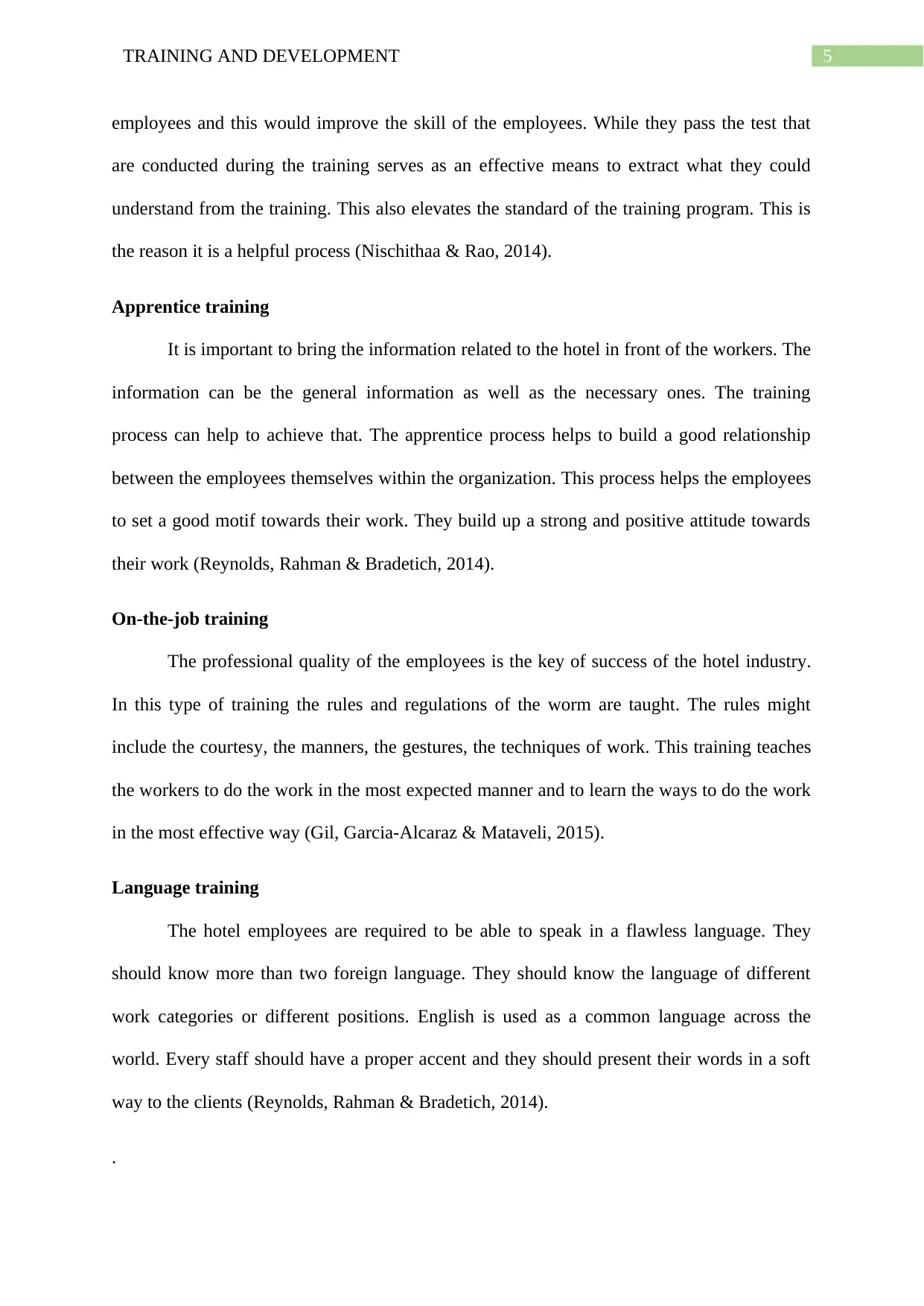
5TRAINING AND DEVELOPMENT
employees and this would improve the skill of the employees. While they pass the test that
are conducted during the training serves as an effective means to extract what they could
understand from the training. This also elevates the standard of the training program. This is
the reason it is a helpful process (Nischithaa & Rao, 2014).
Apprentice training
It is important to bring the information related to the hotel in front of the workers. The
information can be the general information as well as the necessary ones. The training
process can help to achieve that. The apprentice process helps to build a good relationship
between the employees themselves within the organization. This process helps the employees
to set a good motif towards their work. They build up a strong and positive attitude towards
their work (Reynolds, Rahman & Bradetich, 2014).
On-the-job training
The professional quality of the employees is the key of success of the hotel industry.
In this type of training the rules and regulations of the worm are taught. The rules might
include the courtesy, the manners, the gestures, the techniques of work. This training teaches
the workers to do the work in the most expected manner and to learn the ways to do the work
in the most effective way (Gil, Garcia-Alcaraz & Mataveli, 2015).
Language training
The hotel employees are required to be able to speak in a flawless language. They
should know more than two foreign language. They should know the language of different
work categories or different positions. English is used as a common language across the
world. Every staff should have a proper accent and they should present their words in a soft
way to the clients (Reynolds, Rahman & Bradetich, 2014).
.
employees and this would improve the skill of the employees. While they pass the test that
are conducted during the training serves as an effective means to extract what they could
understand from the training. This also elevates the standard of the training program. This is
the reason it is a helpful process (Nischithaa & Rao, 2014).
Apprentice training
It is important to bring the information related to the hotel in front of the workers. The
information can be the general information as well as the necessary ones. The training
process can help to achieve that. The apprentice process helps to build a good relationship
between the employees themselves within the organization. This process helps the employees
to set a good motif towards their work. They build up a strong and positive attitude towards
their work (Reynolds, Rahman & Bradetich, 2014).
On-the-job training
The professional quality of the employees is the key of success of the hotel industry.
In this type of training the rules and regulations of the worm are taught. The rules might
include the courtesy, the manners, the gestures, the techniques of work. This training teaches
the workers to do the work in the most expected manner and to learn the ways to do the work
in the most effective way (Gil, Garcia-Alcaraz & Mataveli, 2015).
Language training
The hotel employees are required to be able to speak in a flawless language. They
should know more than two foreign language. They should know the language of different
work categories or different positions. English is used as a common language across the
world. Every staff should have a proper accent and they should present their words in a soft
way to the clients (Reynolds, Rahman & Bradetich, 2014).
.
⊘ This is a preview!⊘
Do you want full access?
Subscribe today to unlock all pages.

Trusted by 1+ million students worldwide
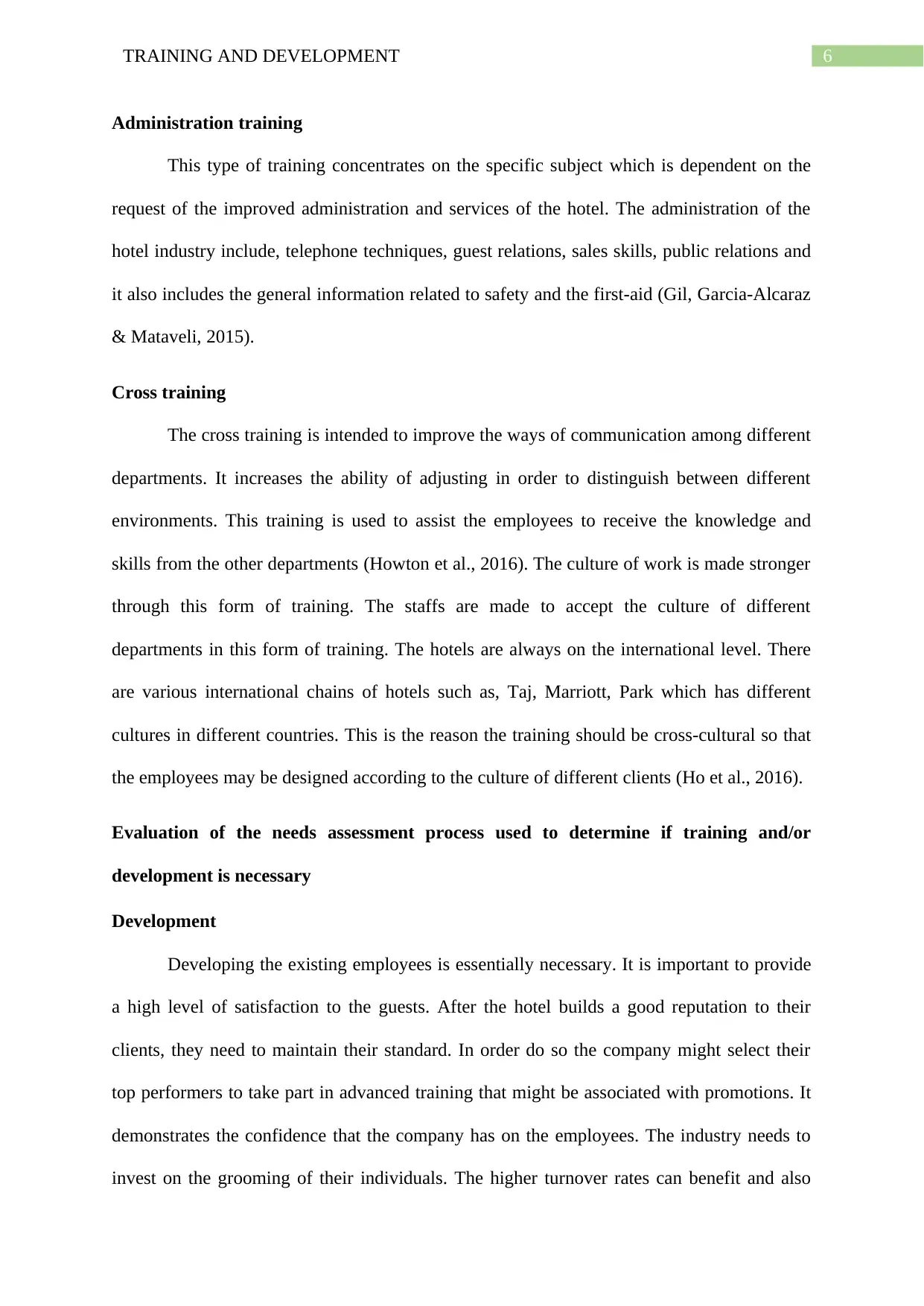
6TRAINING AND DEVELOPMENT
Administration training
This type of training concentrates on the specific subject which is dependent on the
request of the improved administration and services of the hotel. The administration of the
hotel industry include, telephone techniques, guest relations, sales skills, public relations and
it also includes the general information related to safety and the first-aid (Gil, Garcia-Alcaraz
& Mataveli, 2015).
Cross training
The cross training is intended to improve the ways of communication among different
departments. It increases the ability of adjusting in order to distinguish between different
environments. This training is used to assist the employees to receive the knowledge and
skills from the other departments (Howton et al., 2016). The culture of work is made stronger
through this form of training. The staffs are made to accept the culture of different
departments in this form of training. The hotels are always on the international level. There
are various international chains of hotels such as, Taj, Marriott, Park which has different
cultures in different countries. This is the reason the training should be cross-cultural so that
the employees may be designed according to the culture of different clients (Ho et al., 2016).
Evaluation of the needs assessment process used to determine if training and/or
development is necessary
Development
Developing the existing employees is essentially necessary. It is important to provide
a high level of satisfaction to the guests. After the hotel builds a good reputation to their
clients, they need to maintain their standard. In order do so the company might select their
top performers to take part in advanced training that might be associated with promotions. It
demonstrates the confidence that the company has on the employees. The industry needs to
invest on the grooming of their individuals. The higher turnover rates can benefit and also
Administration training
This type of training concentrates on the specific subject which is dependent on the
request of the improved administration and services of the hotel. The administration of the
hotel industry include, telephone techniques, guest relations, sales skills, public relations and
it also includes the general information related to safety and the first-aid (Gil, Garcia-Alcaraz
& Mataveli, 2015).
Cross training
The cross training is intended to improve the ways of communication among different
departments. It increases the ability of adjusting in order to distinguish between different
environments. This training is used to assist the employees to receive the knowledge and
skills from the other departments (Howton et al., 2016). The culture of work is made stronger
through this form of training. The staffs are made to accept the culture of different
departments in this form of training. The hotels are always on the international level. There
are various international chains of hotels such as, Taj, Marriott, Park which has different
cultures in different countries. This is the reason the training should be cross-cultural so that
the employees may be designed according to the culture of different clients (Ho et al., 2016).
Evaluation of the needs assessment process used to determine if training and/or
development is necessary
Development
Developing the existing employees is essentially necessary. It is important to provide
a high level of satisfaction to the guests. After the hotel builds a good reputation to their
clients, they need to maintain their standard. In order do so the company might select their
top performers to take part in advanced training that might be associated with promotions. It
demonstrates the confidence that the company has on the employees. The industry needs to
invest on the grooming of their individuals. The higher turnover rates can benefit and also
Paraphrase This Document
Need a fresh take? Get an instant paraphrase of this document with our AI Paraphraser
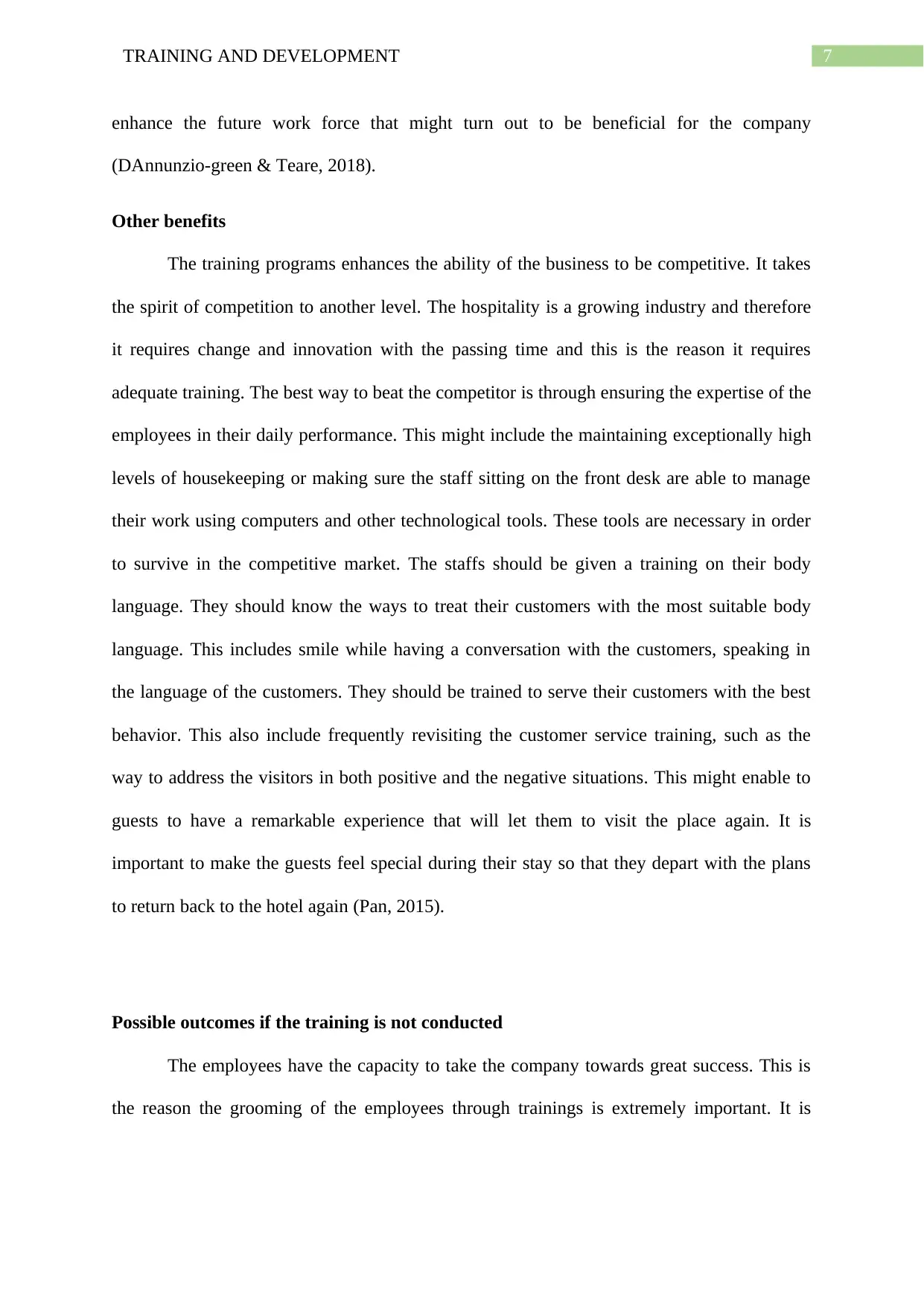
7TRAINING AND DEVELOPMENT
enhance the future work force that might turn out to be beneficial for the company
(DAnnunzio-green & Teare, 2018).
Other benefits
The training programs enhances the ability of the business to be competitive. It takes
the spirit of competition to another level. The hospitality is a growing industry and therefore
it requires change and innovation with the passing time and this is the reason it requires
adequate training. The best way to beat the competitor is through ensuring the expertise of the
employees in their daily performance. This might include the maintaining exceptionally high
levels of housekeeping or making sure the staff sitting on the front desk are able to manage
their work using computers and other technological tools. These tools are necessary in order
to survive in the competitive market. The staffs should be given a training on their body
language. They should know the ways to treat their customers with the most suitable body
language. This includes smile while having a conversation with the customers, speaking in
the language of the customers. They should be trained to serve their customers with the best
behavior. This also include frequently revisiting the customer service training, such as the
way to address the visitors in both positive and the negative situations. This might enable to
guests to have a remarkable experience that will let them to visit the place again. It is
important to make the guests feel special during their stay so that they depart with the plans
to return back to the hotel again (Pan, 2015).
Possible outcomes if the training is not conducted
The employees have the capacity to take the company towards great success. This is
the reason the grooming of the employees through trainings is extremely important. It is
enhance the future work force that might turn out to be beneficial for the company
(DAnnunzio-green & Teare, 2018).
Other benefits
The training programs enhances the ability of the business to be competitive. It takes
the spirit of competition to another level. The hospitality is a growing industry and therefore
it requires change and innovation with the passing time and this is the reason it requires
adequate training. The best way to beat the competitor is through ensuring the expertise of the
employees in their daily performance. This might include the maintaining exceptionally high
levels of housekeeping or making sure the staff sitting on the front desk are able to manage
their work using computers and other technological tools. These tools are necessary in order
to survive in the competitive market. The staffs should be given a training on their body
language. They should know the ways to treat their customers with the most suitable body
language. This includes smile while having a conversation with the customers, speaking in
the language of the customers. They should be trained to serve their customers with the best
behavior. This also include frequently revisiting the customer service training, such as the
way to address the visitors in both positive and the negative situations. This might enable to
guests to have a remarkable experience that will let them to visit the place again. It is
important to make the guests feel special during their stay so that they depart with the plans
to return back to the hotel again (Pan, 2015).
Possible outcomes if the training is not conducted
The employees have the capacity to take the company towards great success. This is
the reason the grooming of the employees through trainings is extremely important. It is
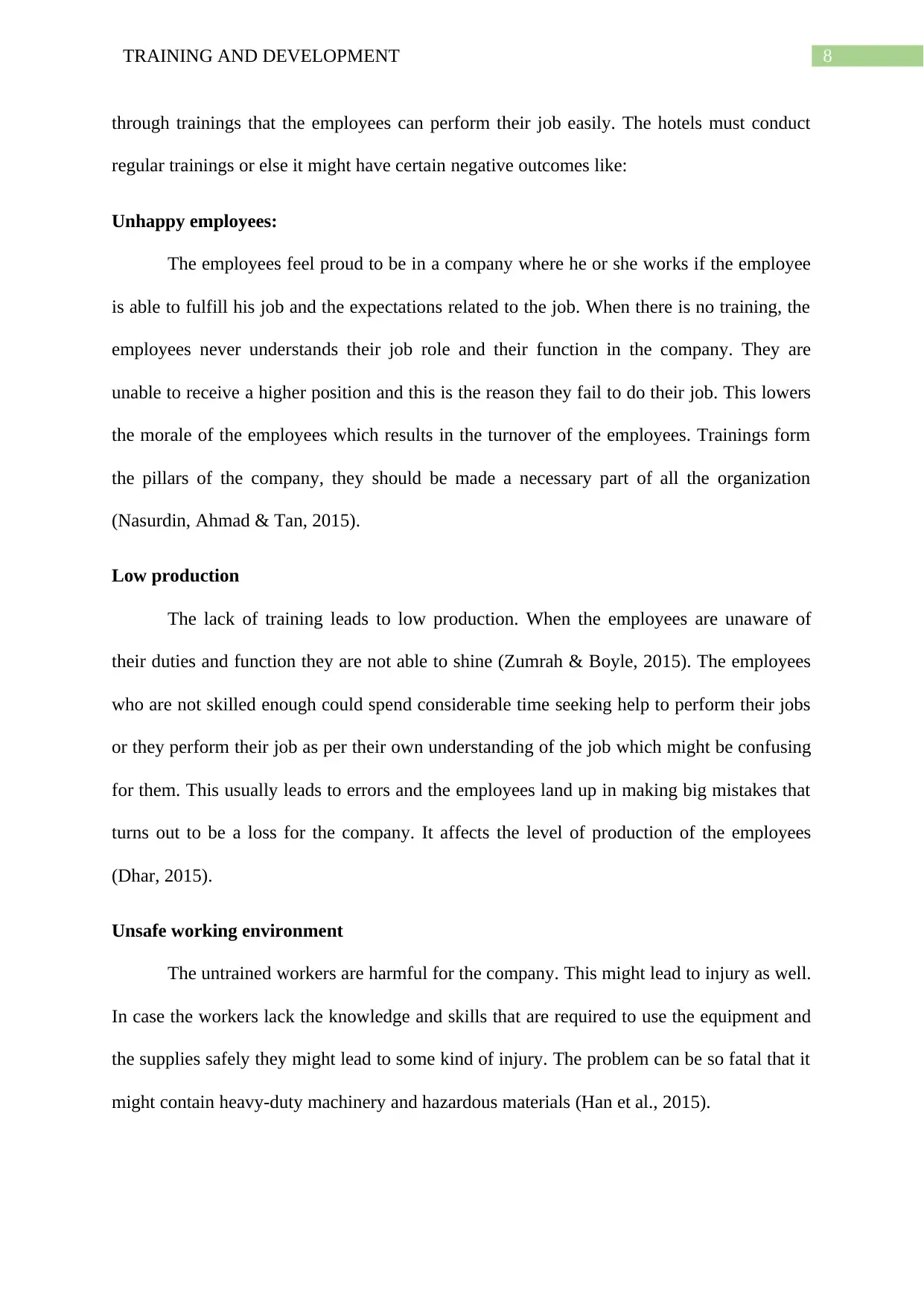
8TRAINING AND DEVELOPMENT
through trainings that the employees can perform their job easily. The hotels must conduct
regular trainings or else it might have certain negative outcomes like:
Unhappy employees:
The employees feel proud to be in a company where he or she works if the employee
is able to fulfill his job and the expectations related to the job. When there is no training, the
employees never understands their job role and their function in the company. They are
unable to receive a higher position and this is the reason they fail to do their job. This lowers
the morale of the employees which results in the turnover of the employees. Trainings form
the pillars of the company, they should be made a necessary part of all the organization
(Nasurdin, Ahmad & Tan, 2015).
Low production
The lack of training leads to low production. When the employees are unaware of
their duties and function they are not able to shine (Zumrah & Boyle, 2015). The employees
who are not skilled enough could spend considerable time seeking help to perform their jobs
or they perform their job as per their own understanding of the job which might be confusing
for them. This usually leads to errors and the employees land up in making big mistakes that
turns out to be a loss for the company. It affects the level of production of the employees
(Dhar, 2015).
Unsafe working environment
The untrained workers are harmful for the company. This might lead to injury as well.
In case the workers lack the knowledge and skills that are required to use the equipment and
the supplies safely they might lead to some kind of injury. The problem can be so fatal that it
might contain heavy-duty machinery and hazardous materials (Han et al., 2015).
through trainings that the employees can perform their job easily. The hotels must conduct
regular trainings or else it might have certain negative outcomes like:
Unhappy employees:
The employees feel proud to be in a company where he or she works if the employee
is able to fulfill his job and the expectations related to the job. When there is no training, the
employees never understands their job role and their function in the company. They are
unable to receive a higher position and this is the reason they fail to do their job. This lowers
the morale of the employees which results in the turnover of the employees. Trainings form
the pillars of the company, they should be made a necessary part of all the organization
(Nasurdin, Ahmad & Tan, 2015).
Low production
The lack of training leads to low production. When the employees are unaware of
their duties and function they are not able to shine (Zumrah & Boyle, 2015). The employees
who are not skilled enough could spend considerable time seeking help to perform their jobs
or they perform their job as per their own understanding of the job which might be confusing
for them. This usually leads to errors and the employees land up in making big mistakes that
turns out to be a loss for the company. It affects the level of production of the employees
(Dhar, 2015).
Unsafe working environment
The untrained workers are harmful for the company. This might lead to injury as well.
In case the workers lack the knowledge and skills that are required to use the equipment and
the supplies safely they might lead to some kind of injury. The problem can be so fatal that it
might contain heavy-duty machinery and hazardous materials (Han et al., 2015).
⊘ This is a preview!⊘
Do you want full access?
Subscribe today to unlock all pages.

Trusted by 1+ million students worldwide
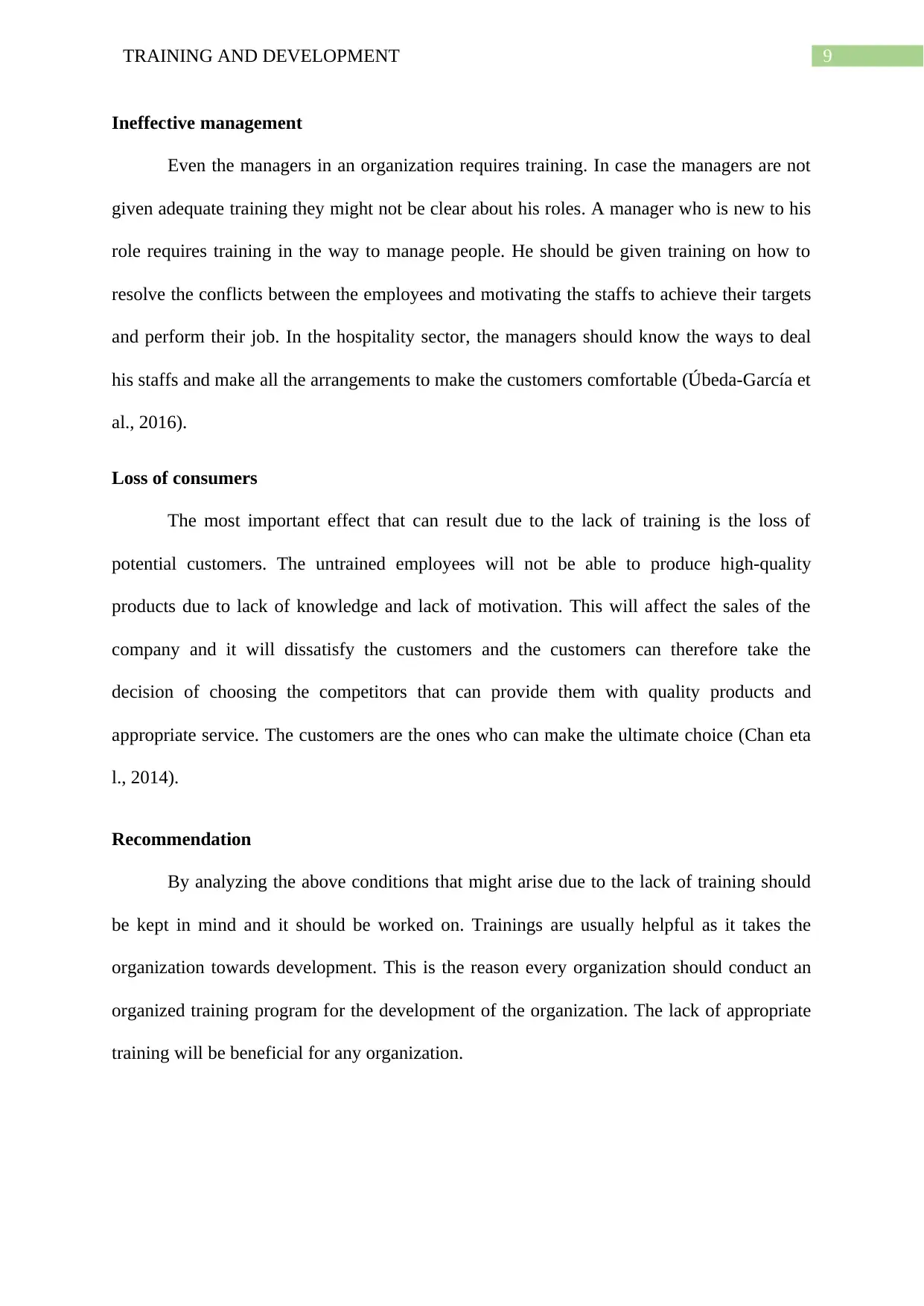
9TRAINING AND DEVELOPMENT
Ineffective management
Even the managers in an organization requires training. In case the managers are not
given adequate training they might not be clear about his roles. A manager who is new to his
role requires training in the way to manage people. He should be given training on how to
resolve the conflicts between the employees and motivating the staffs to achieve their targets
and perform their job. In the hospitality sector, the managers should know the ways to deal
his staffs and make all the arrangements to make the customers comfortable (Úbeda-García et
al., 2016).
Loss of consumers
The most important effect that can result due to the lack of training is the loss of
potential customers. The untrained employees will not be able to produce high-quality
products due to lack of knowledge and lack of motivation. This will affect the sales of the
company and it will dissatisfy the customers and the customers can therefore take the
decision of choosing the competitors that can provide them with quality products and
appropriate service. The customers are the ones who can make the ultimate choice (Chan eta
l., 2014).
Recommendation
By analyzing the above conditions that might arise due to the lack of training should
be kept in mind and it should be worked on. Trainings are usually helpful as it takes the
organization towards development. This is the reason every organization should conduct an
organized training program for the development of the organization. The lack of appropriate
training will be beneficial for any organization.
Ineffective management
Even the managers in an organization requires training. In case the managers are not
given adequate training they might not be clear about his roles. A manager who is new to his
role requires training in the way to manage people. He should be given training on how to
resolve the conflicts between the employees and motivating the staffs to achieve their targets
and perform their job. In the hospitality sector, the managers should know the ways to deal
his staffs and make all the arrangements to make the customers comfortable (Úbeda-García et
al., 2016).
Loss of consumers
The most important effect that can result due to the lack of training is the loss of
potential customers. The untrained employees will not be able to produce high-quality
products due to lack of knowledge and lack of motivation. This will affect the sales of the
company and it will dissatisfy the customers and the customers can therefore take the
decision of choosing the competitors that can provide them with quality products and
appropriate service. The customers are the ones who can make the ultimate choice (Chan eta
l., 2014).
Recommendation
By analyzing the above conditions that might arise due to the lack of training should
be kept in mind and it should be worked on. Trainings are usually helpful as it takes the
organization towards development. This is the reason every organization should conduct an
organized training program for the development of the organization. The lack of appropriate
training will be beneficial for any organization.
Paraphrase This Document
Need a fresh take? Get an instant paraphrase of this document with our AI Paraphraser
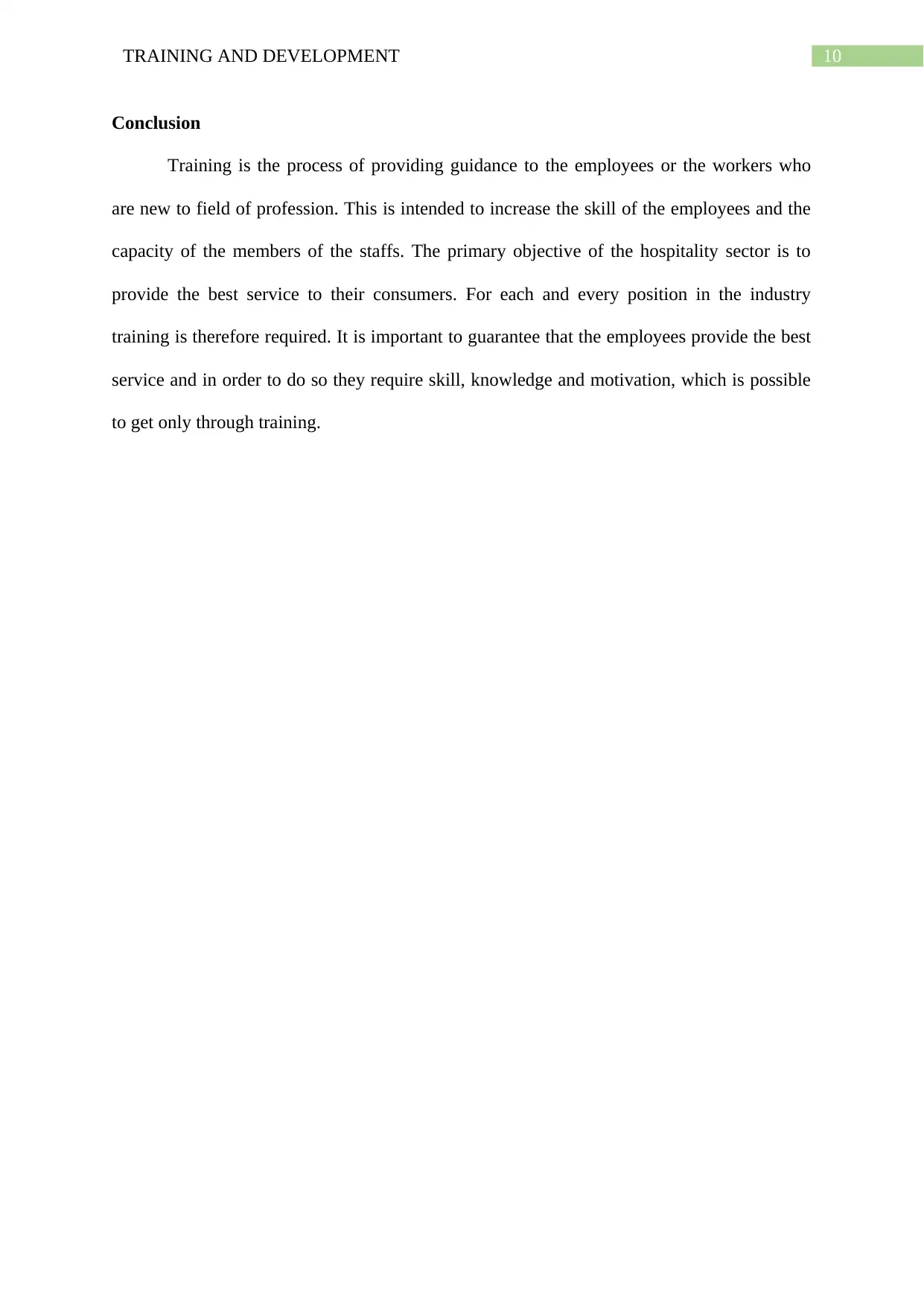
10TRAINING AND DEVELOPMENT
Conclusion
Training is the process of providing guidance to the employees or the workers who
are new to field of profession. This is intended to increase the skill of the employees and the
capacity of the members of the staffs. The primary objective of the hospitality sector is to
provide the best service to their consumers. For each and every position in the industry
training is therefore required. It is important to guarantee that the employees provide the best
service and in order to do so they require skill, knowledge and motivation, which is possible
to get only through training.
Conclusion
Training is the process of providing guidance to the employees or the workers who
are new to field of profession. This is intended to increase the skill of the employees and the
capacity of the members of the staffs. The primary objective of the hospitality sector is to
provide the best service to their consumers. For each and every position in the industry
training is therefore required. It is important to guarantee that the employees provide the best
service and in order to do so they require skill, knowledge and motivation, which is possible
to get only through training.
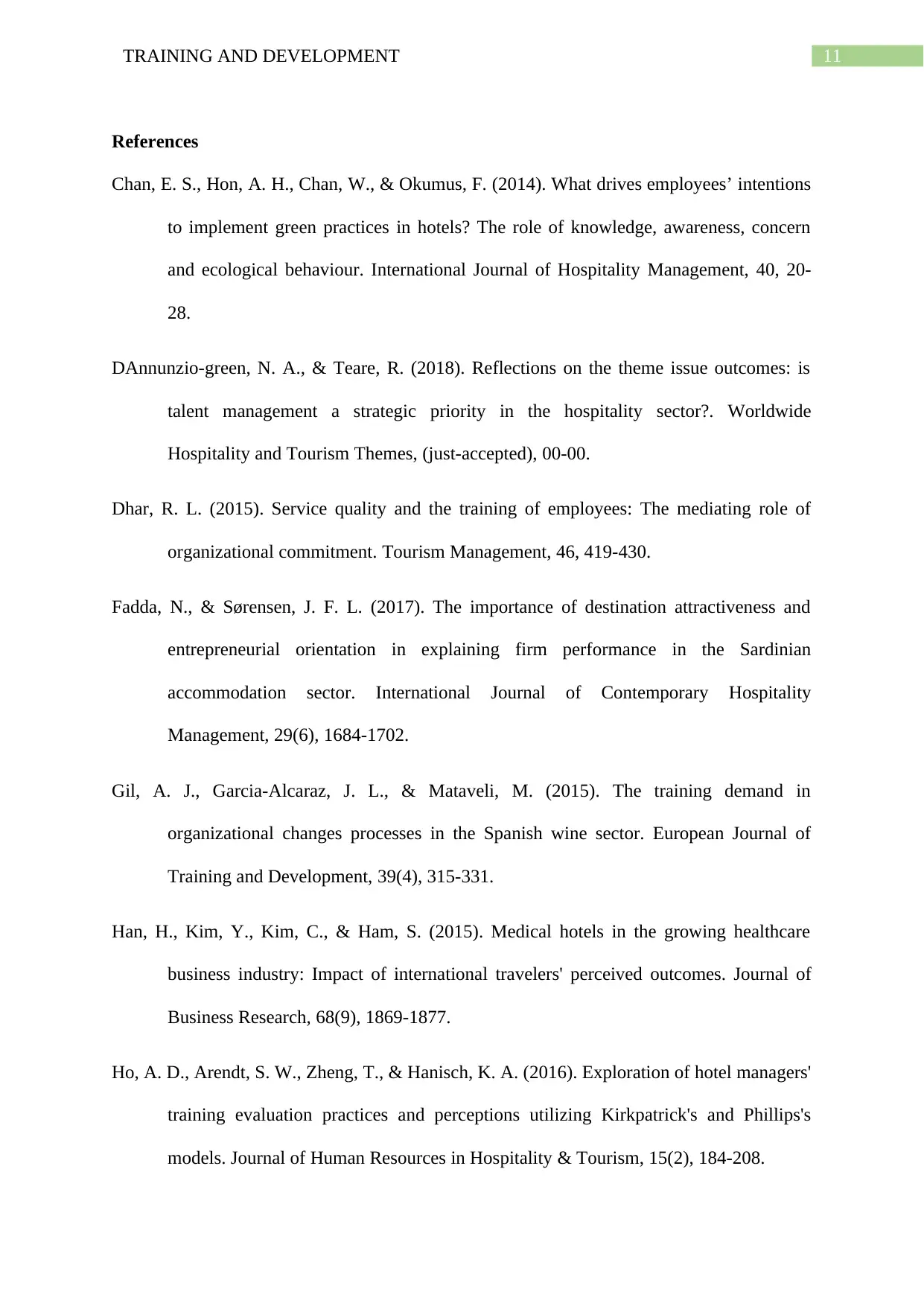
11TRAINING AND DEVELOPMENT
References
Chan, E. S., Hon, A. H., Chan, W., & Okumus, F. (2014). What drives employees’ intentions
to implement green practices in hotels? The role of knowledge, awareness, concern
and ecological behaviour. International Journal of Hospitality Management, 40, 20-
28.
DAnnunzio-green, N. A., & Teare, R. (2018). Reflections on the theme issue outcomes: is
talent management a strategic priority in the hospitality sector?. Worldwide
Hospitality and Tourism Themes, (just-accepted), 00-00.
Dhar, R. L. (2015). Service quality and the training of employees: The mediating role of
organizational commitment. Tourism Management, 46, 419-430.
Fadda, N., & Sørensen, J. F. L. (2017). The importance of destination attractiveness and
entrepreneurial orientation in explaining firm performance in the Sardinian
accommodation sector. International Journal of Contemporary Hospitality
Management, 29(6), 1684-1702.
Gil, A. J., Garcia-Alcaraz, J. L., & Mataveli, M. (2015). The training demand in
organizational changes processes in the Spanish wine sector. European Journal of
Training and Development, 39(4), 315-331.
Han, H., Kim, Y., Kim, C., & Ham, S. (2015). Medical hotels in the growing healthcare
business industry: Impact of international travelers' perceived outcomes. Journal of
Business Research, 68(9), 1869-1877.
Ho, A. D., Arendt, S. W., Zheng, T., & Hanisch, K. A. (2016). Exploration of hotel managers'
training evaluation practices and perceptions utilizing Kirkpatrick's and Phillips's
models. Journal of Human Resources in Hospitality & Tourism, 15(2), 184-208.
References
Chan, E. S., Hon, A. H., Chan, W., & Okumus, F. (2014). What drives employees’ intentions
to implement green practices in hotels? The role of knowledge, awareness, concern
and ecological behaviour. International Journal of Hospitality Management, 40, 20-
28.
DAnnunzio-green, N. A., & Teare, R. (2018). Reflections on the theme issue outcomes: is
talent management a strategic priority in the hospitality sector?. Worldwide
Hospitality and Tourism Themes, (just-accepted), 00-00.
Dhar, R. L. (2015). Service quality and the training of employees: The mediating role of
organizational commitment. Tourism Management, 46, 419-430.
Fadda, N., & Sørensen, J. F. L. (2017). The importance of destination attractiveness and
entrepreneurial orientation in explaining firm performance in the Sardinian
accommodation sector. International Journal of Contemporary Hospitality
Management, 29(6), 1684-1702.
Gil, A. J., Garcia-Alcaraz, J. L., & Mataveli, M. (2015). The training demand in
organizational changes processes in the Spanish wine sector. European Journal of
Training and Development, 39(4), 315-331.
Han, H., Kim, Y., Kim, C., & Ham, S. (2015). Medical hotels in the growing healthcare
business industry: Impact of international travelers' perceived outcomes. Journal of
Business Research, 68(9), 1869-1877.
Ho, A. D., Arendt, S. W., Zheng, T., & Hanisch, K. A. (2016). Exploration of hotel managers'
training evaluation practices and perceptions utilizing Kirkpatrick's and Phillips's
models. Journal of Human Resources in Hospitality & Tourism, 15(2), 184-208.
⊘ This is a preview!⊘
Do you want full access?
Subscribe today to unlock all pages.

Trusted by 1+ million students worldwide
1 out of 14
Related Documents
Your All-in-One AI-Powered Toolkit for Academic Success.
+13062052269
info@desklib.com
Available 24*7 on WhatsApp / Email
![[object Object]](/_next/static/media/star-bottom.7253800d.svg)
Unlock your academic potential
Copyright © 2020–2025 A2Z Services. All Rights Reserved. Developed and managed by ZUCOL.




